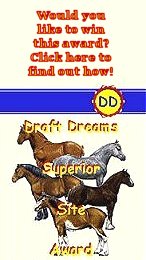
People around the world have depicted in their minds a vision of heavy, brutish-looking strength and feathered legs and long-eared beasts of burden when it comes to draft animals. However the word "draft," according to Webster's dictionary, means "used or adapted for drawing loads." Light horses are quite often "draft" horses as well. As a matter of fact, some of the most popular breeds today, such as the Irish Draught Sport horse, originated from heavy Draft breeds. This site will give those that don't really know the true beauty of draft animals the facts about them- while there ARE the heavy types with the feathered legs, they are not all that way. This site is also a wonderful resource for those that already do appreciate these versatile animals.
 |
At this moment in time, this site is devoted almost exclusively to draft horses. In the future, you will begin to see more information and resources for mules, asses, donkeys, burros, and draft ponies. If you would like updates about this site, then be sure to add your email address to our updates list. For the most part, draft horses come in three basic types; Heavy Drafts, Medium Drafts, and Light Drafts. Their body mass and weight decreases respectively. The best-known examples of Draft Horses in the U.S. are probably the famous Budweiser Clydesdales that pull the Anheuser-Busch beer wagons. But draft horses of all breeds, shapes, colors, and sizes have captured the hearts of millions around the world, whether you are a breeder, a farmer, an owner, or even just a draft animal lover.
|
Draft animals can, and often do, weigh up to and beyond 2000 pounds! They can stand up to 20 hands high (6 feet 7 inches at the point of their shoulder). Considering that an average saddle horse (a horse used mainly for riding) weighs half that, and stands only 14 or 15 hands high, just the size of these beauties is impressive!! But to counteract their often-intimidating size, nearly all draft animals are calm, obedient, even tempered, and they are often the sweetest animals you'll ever meet.
The most common breeds of draft horses (albeit not necessarily the most popular) are the Clydesdale, the Percheron, the Belgian, and the Shire, each having its own characteristic style and conformation. In temperament, most draft animals are usually friendly and good-natured, and steady, willing workers. But there are scores of lesser-known breeds, as well.
Draft animals were, for the most part, bred for their strength and endurance. In the medieval times, and even before that, draft horses often carried knights into battle, and the weight of the armor alone necessitated brute strength. They were also used for farm work, and needed that same strength to drag heavy plows through solid soil. Draft animals were also bred for forestry work, and in the rough mountain terrains.
After World War I, however, with the industrial age beginning, the truck and the tractor were taking over, and thousands of draft horses were slaughtered. But in the more recent past, more and more people have found a rekindled interest in these fascinating animals, and slowly, some of the breeds are being revived. Through careful crossbreeding and meticulous record keeping, breeders have been fairly successful in re-creating and rescuing some of the more endangered breeds.
This renewed interest in draft animals has fired up a passion both for show and competition, and also in some areas for farming and logging in order to preserve the environment. Tractor drivers are also less likely to feel the deep satisfaction that doing work with draft animals produces!
Whether all decked up in their finery, or all grubby and sweaty from their dirty work, these animals are surely heart-winning creatures. I hope that from this site you can recognize my passion and love for these creatures, and I hope that you can share that enthusiasm with me. Just try to look into the gentle, liquid eye of a draft animal and not fall in love. Welcome.

(Click the eye to continue.)
All images on this page copyrighted by A Rivas 1999, 2000, 20001